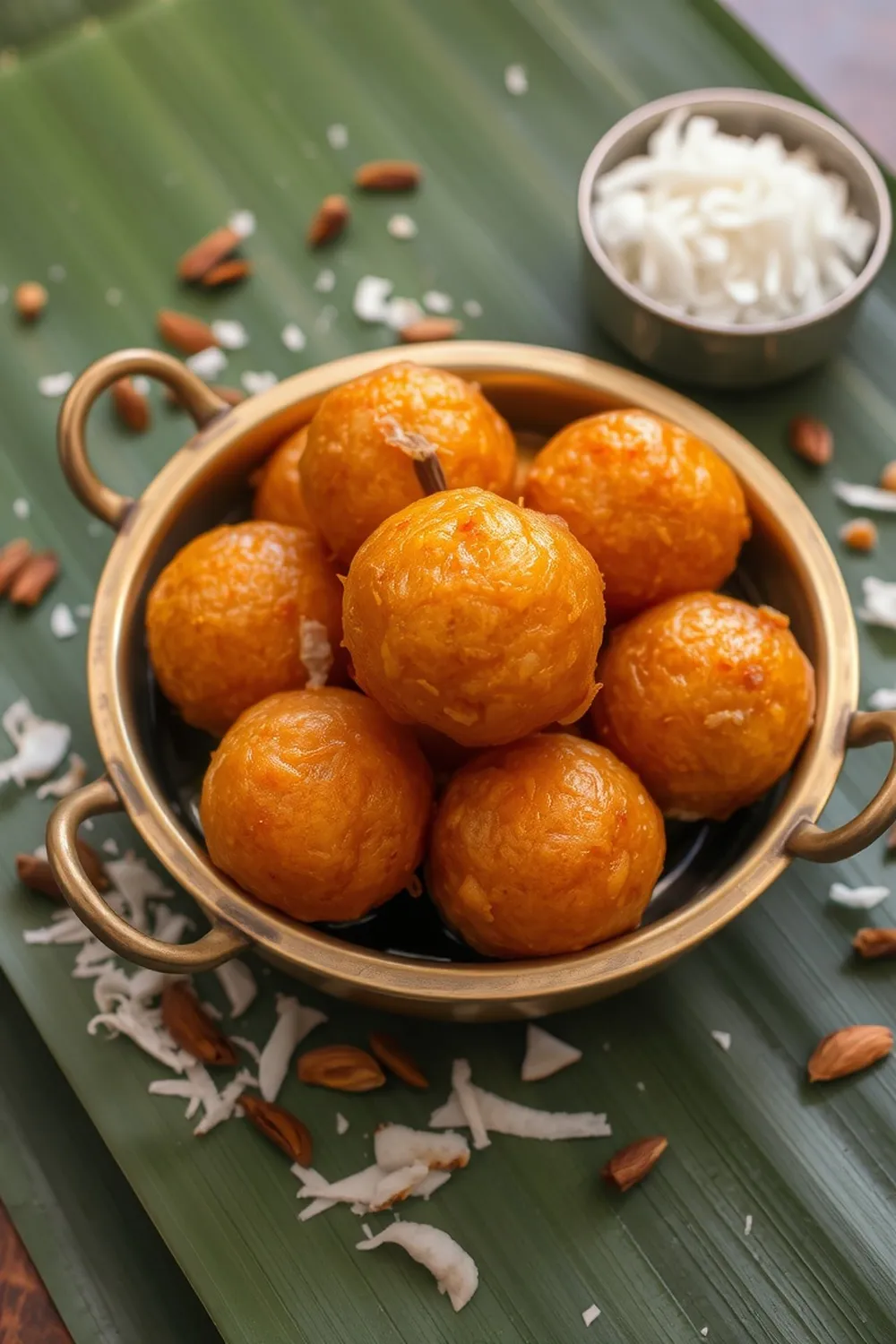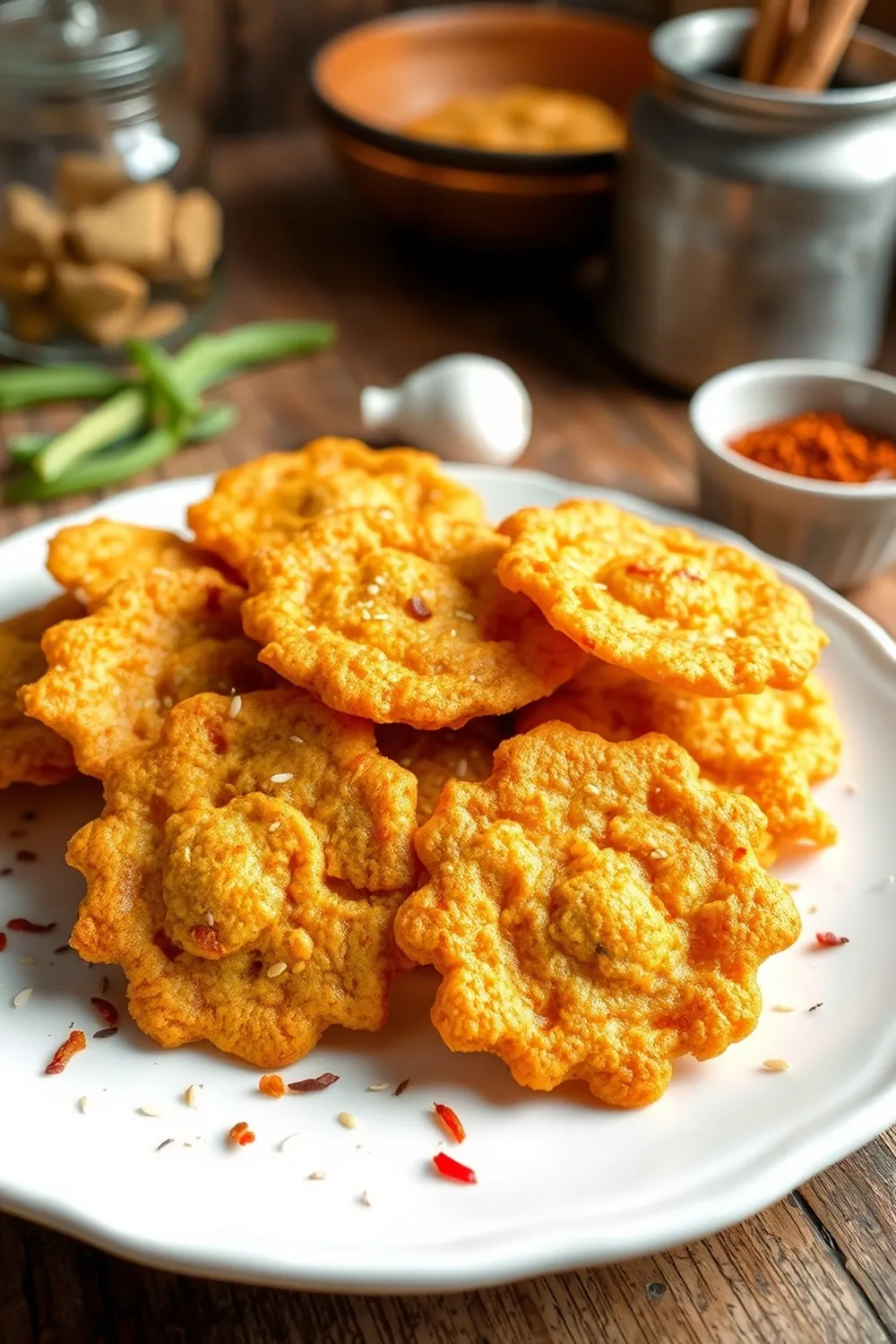- Soak raw rice in water for at least 4 hours, or preferably overnight. Drain, but do not squeeze out all the moisture.
- Grind the soaked rice into a fine flour. Sieve the flour to remove any coarse particles and store, covered, at room temperature.
- Melt jaggery in a pan with a little water, strain to remove impurities, and boil until it reaches soft-ball consistency (test by dropping a small amount of syrup into cold water).
- Mix the jaggery syrup with the rice flour. Add cardamom powder and sesame seeds. Combine to form a smooth dough. Add a little water if needed.
- Let the dough rest, covered, at room temperature for 12-24 hours. Longer resting times improve texture.
- Shape the dough into small balls. Flatten each ball between ghee-greased parchment paper or plastic sheets to a medium thickness.
- Fry in hot oil (around 300°F/150°C) until golden brown, gently pressing with a spatula to maintain shape. Avoid overcrowding the pan.
- Drain the fried sweets on paper towels to remove excess oil and serve once cooled to room temperature.
- Calories:220 kcal25%
- Energy:920 kJ22%
- Protein:2 g28%
- Carbohydrates:35 mg40%
- Sugar:20 mg8%
- Salt:5 g25%
- Fat:8 g20%
Last Updated on 4 months by Neha Deshmukh
Authentic Rice & Jaggery Peda Recipe – Sesame Cardamom Sweet
Introduction
Oh, pedas! These little sweet discs just melt in your mouth, don’t they? I remember my grandmother making these during Diwali, and the whole house would smell of warm jaggery and cardamom. It’s a scent that instantly takes me back to childhood. Today, I’m sharing my version of this classic Indian sweet – a simple, authentic rice and jaggery peda, studded with sesame seeds and a hint of cardamom. It’s a little bit of effort, but trust me, the results are so worth it.
Why You’ll Love This Recipe
This recipe isn’t just about a delicious sweet; it’s about connecting with tradition. These pedas are naturally gluten-free and can easily be made vegan (more on that later!). They’re perfect for festivals, gifting, or just a little self-care treat with your evening chai. Plus, the combination of rice, jaggery, sesame, and cardamom is just heavenly.
Ingredients
Here’s what you’ll need to make these delightful pedas:
- 1 cup Raw Rice (approximately 150g)
- 1 cup Jaggery (approximately 200g)
- 1 tsp Sesame seeds (about 7g)
- Oil for deep frying (approximately 500ml)
- 1 tsp Ghee (about 7g)
- 2 pinches Cardamom powder (about 1g)
Ingredient Notes
Let’s talk ingredients! Getting these right makes all the difference.
- Raw Rice Varieties for Peda: You want a short-grain raw rice for the best texture. Think sona masuri or even a good quality idli rice. Avoid long-grain rice like basmati, as it won’t bind as well.
- Jaggery: Types and Flavor Profiles: Jaggery comes in different forms – dark, light, and even powdered. I prefer using dark jaggery for a richer, more caramel-like flavor. If you use powdered jaggery, you might need a little less liquid when making the syrup.
- The Significance of Sesame Seeds in Indian Sweets: Sesame seeds aren’t just for flavor! They’re considered auspicious in Indian culture and add a lovely nutty crunch.
- Cardamom: Aromatic Enhancement: Freshly ground cardamom is always best, but a good quality cardamom powder works beautifully too. Don’t skimp – it really elevates the flavor!
- Oil for Deep Frying: Choosing the Right Kind: Any neutral-flavored oil with a high smoke point will work. I usually use groundnut oil or sunflower oil.
Step-By-Step Instructions
Alright, let’s get cooking!
- First, soak the raw rice in water for about an hour. This softens it up for grinding. Don’t discard the water after soaking – we want the rice to stay a little damp.
- Drain the rice, but don’t let it dry completely. Grind it into a fine flour. A little moisture helps with the grinding process. Sieve the flour to remove any coarse bits and store it covered.
- Now for the jaggery. Melt the jaggery in a pan with a splash of water. Strain it through a fine-mesh sieve to remove any impurities. Boil the jaggery syrup until it reaches the soft-ball consistency. (See the ‘Expert Tips’ section for how to test this!)
- Pour the hot jaggery syrup into the rice flour. Add the cardamom powder and sesame seeds. Mix everything together really well – this can get a little messy! – until it forms a smooth, pliable dough.
- Cover the dough and let it rest at room temperature for anywhere between 12 to 48 hours. This is crucial for the pedas to have the right texture. Seriously, don’t skip this step!
- After resting, take a small portion of the dough and shape it into a ball. Flatten it gently between your palms or using a rolling pin, to about medium thickness.
- Heat the oil for deep frying on low heat. Gently slide the pedas into the hot oil and fry until they’re golden brown, pressing gently with a ladle to help them cook evenly.
- Drain the fried pedas on paper towels to remove excess oil. Let them cool completely before serving.
Expert Tips
A few little secrets to peda perfection:
- Achieving the Perfect Soft-Ball Consistency for Jaggery: Drop a tiny bit of the jaggery syrup into a bowl of cold water. If it forms a soft, pliable ball that you can easily shape, it’s ready. If it dissolves, it needs to boil longer.
- Resting the Dough: The Key to Texture: The resting period allows the rice flour to fully absorb the jaggery syrup, resulting in a soft, melt-in-your-mouth texture.
- Frying Techniques for Evenly Cooked Pedas: Keep the heat low to prevent the pedas from burning. Gently pressing them with a ladle ensures they cook through evenly.
Variations
Want to get creative? Here are a few ideas:
- Vegan Peda Adaptation: Substitute the ghee with a vegan butter alternative or a little extra oil when shaping the pedas.
- Gluten-Free Confirmation: This recipe is naturally gluten-free, as long as you ensure your rice flour is certified gluten-free.
- Adjusting Sweetness Levels: If you prefer less sweet pedas, reduce the amount of jaggery slightly.
- Festival Adaptations (Diwali, Ganesh Chaturthi, etc.): My aunt always adds a few strands of saffron to the dough during Diwali for a beautiful color and aroma. For Ganesh Chaturthi, she shapes them into little modaks!
Serving Suggestions
These pedas are delicious on their own, but they also pair beautifully with a warm glass of milk or a cup of masala chai. They make a lovely offering for guests or a sweet treat to enjoy with family.
Storage Instructions
Store the cooled pedas in an airtight container at room temperature for up to 5 days. They tend to harden slightly over time, but a quick microwave for a few seconds will soften them up.
FAQs
Let’s answer some common questions:
- What type of rice works best for making peda? Short-grain rice like sona masuri or idli rice is ideal.
- Can I use sugar instead of jaggery in this recipe? You can, but the flavor will be different. Jaggery gives a unique caramel-like taste that sugar doesn’t.
- How do I know when the jaggery has reached the soft-ball consistency? The soft-ball test is the way to go! Drop a tiny bit into cold water – it should form a soft, pliable ball.
- What if my peda dough is too dry or too sticky? If it’s too dry, add a teaspoon of water at a time. If it’s too sticky, add a tablespoon of rice flour.
- How long can I store these pedas, and what’s the best way to keep them fresh? Store in an airtight container at room temperature for up to 5 days.
- Can I add other nuts or seeds to the peda dough? Absolutely! Chopped almonds, pistachios, or even a sprinkle of poppy seeds would be delicious.










